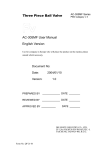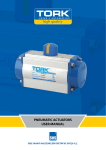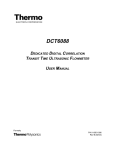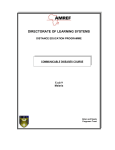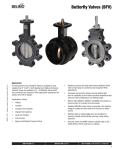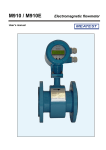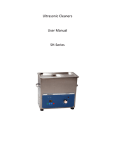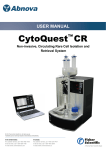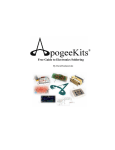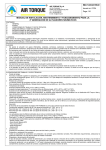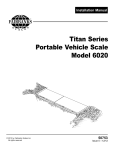Download USER`S MANUAL
Transcript
1-800-899-0553 assuredautomation.com 36 Series Stainless Steel 2-way Full Port Ball Valve USER’S MANUAL Installation & Maintenance Assured Automation • 19 Walnut Avenue, Clark, New Jersey 07066 • Tel: 732-381-2255 • Fax: 732-381-2383 TABLE OF CONTENTS 1. 2. 3. 4. 5. 6. 7. 8. 9. 10. 11. General Precaution 1.1. Material Section ........................................................................................1 1.2. Pressure-Temperature Rating ....................................................................1 1.3. Fluid Thermal Expansion ..........................................................................1 1.4. Static Electric Effect..................................................................................1 1.5. Liquids with High Fluid Velocity .............................................................1 1.6. Throttling Service......................................................................................1 1.7. Disassembling Valve.................................................................................1 1.8. Skin Contact with the Valve Surface ........................................................1 1.9. Fluid Contact with the Valve.....................................................................1 1.10. Locking Device .........................................................................................1 Product Description 2.1. Feature .......................................................................................................1 2.2. Product Specification ................................................................................2 2.3. Dimensions ................................................................................................2 Design Specification..........................................................................................2 Pressure Temperature Rating .........................................................................3 Delivery Condition and Storage ......................................................................3 Valve Installation 6.1. Handling ....................................................................................................3 6.2. Cleaning.....................................................................................................3 6.3. Flow Direction...........................................................................................3 6.4. Position and Weight Support.....................................................................3 6.5. Installation of Threaded End Valve...........................................................4 6.6. Installation of Weld End Valve .................................................................4 6.7. Systems Hydrostatic Test ..........................................................................4 Valve Operation 7.1. Manual Operation......................................................................................4 7.2. Automatic Operation .................................................................................4 Maintenance 8.1. Maintenance Frequency ............................................................................5 8.2. Disassembling and Cleaning the Valve.....................................................5 8.3. Replacing Seats and Joint Gaskets ............................................................5 8.4. Replacing Stem Sealing Components .......................................................5 Torque Data 9.1. Valve Assembly Torque Table..................................................................6 9.2. Valve Operation Torque Table..................................................................6 Assembly Diagram ............................................................................................7 Corrosion Data ..................................................................................................8 APPENDIX........................................................................................................i ~ xiii 1. General Precaution 1.1. Material Section Material deterioration is determined by the contained fluid. The need for period inspection must be determined by user based on the contained fluid. Among possible cases of deterioration are carbide phase conversion to graphite, oxidation of ferrite materials, decrease in ductility of carbon steels at low temperature (even in applications above 29°C). Although information about corrosion data is provided in this user‘s manual, the user should pay special attention to determine the suitability of material in his own specific application 1.2. Pressure-Temperature Rating Stated rating is considered for static pressure only. Please refer to P & T rating section on page 3 for working precaution. The allowable temperature range is between ambient temperature and 200°C. DO NOT exceed the temperature range. Exceeding the temperature range could result in serious accidents 1.3. Fluid Thermal Expansion When the valve is subjected to extreme variation in ambient temperature, fluid thermal expansion might cause the ball valve to exceed intended operating pressure. This condition tends to be more severe when the ball valve is left in closed position for a long period of time during extreme temperature variation. While our valve is designed to equalize the pressure within the ball valve cavities, the user must take measures to ensure that the valve does not exceed it rated pressure due to fluid thermal expansion 1.4. Static Electric Effect The ball valve has an internal anti-static design. It is designed to provided electric continuity between ball, stem, and body. When service conditions require electrical continuity to prevent static discharge, the user is responsible for providing static grounding 1.5. Liquids with High Fluid Velocity When your application calls for frequent high fluid velocity, please contact our distributor for advise on minimizing the possibility of seat deformation, especially when ball valves are subjected to high pressure and high temperature lines 1.6. Throttling Service Ball valves are generally not recommended for throttling service. The fluid flow and the leading edge of the ball can damage or deform the resilient ball seats. High fluid velocity or the presence of solid particles in the pipeline will further reduce the seat life in throttling applications 1.7. Disassembling Valve Do not disassemble or loosen any part of valve while it is under pressure. When the valve is not equipped with pressure sensing device, user should check the line pressure by other method through the piping system 1.8. Skin Contact with the Valve Surface When the valve is in service, do not touch the valve surface until you can be sure that it is within the safe temperature range for touching 1.9. Fluid contact with the Valve Do not use the valve on fluids that are corrosive or inappropriate to any part of the valve. Please review the corrosion data on page 8 for more information 1.10. Locking Device To guard against valve being operated by unauthorized personnel, lockable ball valve is available as an option. However, the pad lock must be provided by the customer. 2. Product Description 2.1. Feature a. Full bore ball valve with ISO5211 mounting pad for direct mounting to actuator with DIN3337 standard b. Easily retrofitted with manual handle, double acting actuator, or single acting actuator -1- c. d. e. f. g. h. i. Options of threaded end, socket weld end, or butt weld end with face to face dimensions according to DIN3202-M3 Three-Piece design enables in-line maintenance Special pyramidal stem design for exceptional stem sealing during high cycle operation Blowout proof stem Anti-static design with electric continuity for ball, stem, and body Self pressure relief seat to prevent pressure built up Optional handle or lockable handle available to prevent unauthorized valve operation 2.2. Product Specification Product Code PN MODEL 36T (THREADED) MODEL 36B (BUTT WELD) MODEL 36S (SOCKET WELD) NO CE Marking 63 DN 8, DN10, DN15, DN20, DN25 CE Category II DN32, DN40, DN50, DN65, DN80, DN100 2.3. Dimensions (mm) 3. Design Specification Items Pressure and Temperature Rating Designed to Testing According to Standards and Codes PrEN12516-1 PrEN 1226-1 EN10213-4 for 1.4408 EN10213-4 for 1.4308 EN 10213-2 for 1.0619 ISO-3506 (A2-70) Material of Casting (Body, Cap, Ball) Bolt and Nut -2- 4. Pressure Temperature Rating The pressure temperature rating of the ball valve is determined, not only by the valve shell material, but also by the sealing material of ball seat, stem packing, and body seal. Choice of sealing materials should be based on, all the factors including but not limited to, the service media, service temperature, service pressure, media velocity within the line, frequency of valve operation and size of the ball valve. The following chart shows pressure vs. temperature rating for non-shock fluid service for different seat material. Please refer to general precautions section on page 1 for more information 5. Delivery Condition and Storage a. Valves are set to open position and individually bagged prior to shipment b. Upon delivery, customer’s quality control must check the package to make sure that the valves are not damaged during the shipping process c. Valves must also be checked for loosening of bolts due to shipment d. Valves should be stored indoors and in its original package 6. Valve Installation 6.1. Handling To ensure safety, user must handle the valve with both hands so that the weight of the valve is equally distributed at both ends. If a hoist is used to lift large valve, user must make sure the hoist is strong enough to support the weight of the valve 6.2. Cleaning To prevent damage to the seats and ball surface, the user must inspect the valve for dirt, burrs and welding residues prior to installation. Although all valves were cleaned and bagged prior to delivery, if for some unforeseen circumstances that the valves were soiled during transportation, the user must clean the valve prior to installation. The user may clean the valve by water, steam or pressurized air 6.3. Flow Direction Our valves are bi-directional, meaning upstream or downstream could be at either end of the valve 6.4. Position and Weight Support The weight of the valve must be properly supported by means other than the connected pipelines. The valve end connection and the pipeline forms an integral sealing zone. If -3- the weight of the valve is entirely distributed to the joint area, the valve will deform and cause leakage 6.5. Installation of Threaded End Valve a. Use conventional sealant, such as hemp core, PFA-lined, etc b. Use wrench and apply force on the hexagon end of the valve only. Apply force to other area of valve may seriously damage the valve c. For applications where threaded end valves are back-welded on site, the valves must be dismantled according to instructions for weld end valves 6.6. Installation of Weld End Valve a. Tack-weld the valve on the pipe in four points on both end caps. b. With the valve in open position (see valve position diagram on page 4), loosen all the nuts on the body bolts c. Remove all the bolts except one d. Swing the body outside the pipe e. Turn the handle to the half open position to assist in the removal of the seats and body gaskets f. Turn the handle to the closed position and remove the ball g. Place all removed parts in a clean and secure place h. Replace the body and the removed bolt. Tighten all nuts slightly. To prevent any leakage to the body joints after welding, make sure that the body and the end caps remain perfectly parallel i. Finish welding both end caps onto the pipe j. After the pipeline and valve cool, clean end caps then remove the previous replace bolt. Swing out the body. Turn the valve to the closed position, then replace the ball. Turn valve in open position and replace seats and body gaskets k. After seats, body gaskets and ball are replaced, swing the body into position, replace the removed bolts and nuts, and tighten the nuts according to the valve assembly torque table on page 6 6.7. Systems Hydrostatic Test Before delivery, our valves are tested to 1.5 times the allowable pressure at ambient temperature in the open position. After installation, the pipeline may be subjected to system test pressure of no more than 1.5 times the rated pressure 7. Valve Operation 7.1. Manual Operation Handle is offered as an option a. Valve in Open Position is indicated by handle in parallel (in-line) with the valve or pipeline b. Valve in Closed Position is indicated by handle in perpendicular (crossed with the valve or pipeline 7.2. Automatic Operation a. Prior to actuator installation the position of the valve is indicated as shown in the illustrations below with a line indicator on top of the valve stem OPEN CLOSE -4- b. After Actuator installation, valve should be check for valve stem alignment. Angular or linear misalignment will result in high operational torque and unnecessary wear on the stem seal 8. Maintenance 8.1. Maintenance Frequency User should determine the maintenance frequency depending on specific application. If there is sign of leakage from the stem, it is time to replace the stem sealing components. If there is sign of internal leakage, it is time to replace the seats and gasket components. Life of the valve can be maximized if the valve is used within the rated range, in accordance with pressure, temperature, and corrosion data 8.2. Disassembling and Cleaning the Valve Ball valve can trap fluids in ball cavity when it is in the closed position. If the valve has been used in hazardous media, it must be decontaminated before disassembly. a. Relieve the line pressure b. Place valve in half-open position and flush the line to remove any hazardous material from valve c. All persons involved in the removal and disassembly of the valve should wear proper protective clothing, such as face shield, glove, apron, etc 8.3. Replacing Seats and Joint Gaskets Seat and joint gaskets should be replaced at the same time. Once the valve is disassembly for seat service, the gasket should also be replaced to ensure proper body sealing a. Follow the direction on Disassembling & Cleaning the valve. Make sure the pipeline is de-pressurized b. With the valve in open position (see valve position diagram on page 4), loosen all the nuts on the body bolting. Remove all the bolts except one. Swing the body outside the pipe. c. Turn the handle to the half open position to assist in the removal of the seats d. Replace with a new set of seats and body gaskets e. Swing the body back into position. Replace the removed bolts, and tighten the bolts according the valve assembly torque table on page 6 8.4. Replacing Stem Sealing Components a. Follow the direction for replacing the seats and joint gaskets from a. to c. b. To assist in loosening of the disc plate, place a rod of diameter smaller than the ball orifice into the ball orifice. Loosen and remove the disc plate with two-prone tool. Remove the set of Belleville washers and the gland. Place all removed parts in a clean and secure place c. Remove the rod. Turn the valve to the closed position (see valve position diagram on page 4). Remove the seats and body gaskets. The ball should slide out with a gentle push. Place all removed parts in a clean and secure place d. Push the stem downward. It should come out through the center body. Remove the stem then remove the pyramidal stem seal. Thoroughly clean the stem. Replace with a new pyramidal stem seal. e. Remove the v-ring stem packing from the center body cavity. Thoroughly clean the center body. Replace with a new v-ring stem packing. f. Replace the stem, the Belleville washers and the gland. Replace the disc plate. To tighten the disc plate, hold the stem in place and tighten the disc plate with two-prone tool. Refer to the stem disc torque in the valve assembly torque table on page 6 for the correct torque value. g. Turn the valve to the closed position (see valve position diagram on page 4).. Replace the ball. Turn the valve to the open position. Replace the seats and joint gaskets. h. Swing the center body back into position. Replace the removed bolts and nuts. Tighten the nuts according to valve assembly torque table on page 6. -5- 9. Torque Data 9.1. Valve Assembly Torque Table This torque table shows the required torque that is needed to tighten the valve stem and valve body bolt. It is very important that these torque values are applied with tolerance of no more or no less than 10%. Incorrect torque values might result in improper sealing of the valve or deformation of the bolts. Size Stem Disc Torque (NM) Body Bolt Torque (NM) 1/4" DN8 3/8" DN10 1/2" DN15 3/4" DN20 1" DN25 1 1/4" DN32 1 1/2" DN40 2" DN50 2 1/2" DN65 3" DN80 4" DN100 12 12 12 12 17 17 24 24 35 35 40 8 8 18 18 18 34 34 59 113 113 113 9.2. Valve Operation Torque Table The table below lists break torque values for PTFE seat in clear non-viscous fluid. Torque value can vary depending on temperature, pressure, line medium, and seat material Differential 75 PSI 150 PSI 300 PSI 700 PSI 1000 PSI Pressure 5 BAR 10 BAR 20 BAR 50 BAR 63 BAR Valve Size IN-LB NM IN-LB NM IN-LB NM IN-LB NM IN-LB NM 1/4", 3/8" DN8/10 45 5.1 45 5.1 45 5.1 45 5.1 45 5.1 1/2" DN15 60 6.8 60 6.8 60 6.8 60 6.8 60 6.8 3/4" DN20 80 9.0 80 9.0 80 9.0 80 9.0 80 9.0 1" DN25 130 14.7 130 14.7 130 14.7 130 14.7 130 14.7 1 1/4" DN32 160 18.1 160 18.1 160 18.1 180 20.3 190 21.5 1 1/2" DN40 200 22.6 200 22.6 260 29.4 300 33.9 350 39.5 2" DN50 280 31.6 375 42.4 400 45.2 450 50.8 480 54.2 2 1/2" DN65 500 56.5 600 67.8 620 70.1 800 90.4 3" DN80 650 73.4 800 90.4 900 101.7 1300 146.9 4" DN100 1100 124.3 1500 169.5 1900 214.7 2400 271.2 a. For dry gas, increase the above torque value by 15% b. For viscous fluid or fluids with solid or abrasive contents, increase the above torque value by 35% c. For 15% glass fiber filled PTFE (RPTFE) seats, increase the above torque value by 15% d. For 25% carbon fiber filled PTFE (CTFE) seats, increase the above torque value by 25% e. For 50% stainless steel powder filled PTFE seats, increase the above torque value by 25% f. A safety factory of 20% is recommended for actuator sizing -6- 10. Assembly Diagram -7- 11. Corrosion Data The chart in Appendix is intended to serve as a guide to material selection for your particular application. No one material can be expected to resist corrosive action of wide variety of chemical that is used in the industry today. The physical properties of a material are affected differently by each corrosive medium. It is sometimes necessary to sacrifice values in one property to gain the maximum value in another property. It is, therefore, important for user to decide which property is of prime importance for the particular application. A = Excellent B = Good Explanation of Rating C = Poor D = Do not use X = No Information *A = Excellent with PTFE but Do not use with filled PTFE Internal moving parts that are in contact with the media ideally should carry an “A” rating. Body materials in direct contact with the media can carry a “B” rating because the rate of corrosion is not fast enough to become a serious problem. Note: Rating are based on media at room temperature. When Using the chart, please remember that factors such as solution concentration, temperature, degree of agitation and presence of impurities can effect rate of corrosion. Apex Controls Co., Ltd. can not accept responsibility for problems arising from use of these data. We suggest that in critical applications, tests be conducted to verify suitability of material prior to usage. -8- Appendix: Corrosion Data Chart Chemicals Acetaldehyde Acetamine Acetate Solvents Acetic Acid, aerated Acetic Acid, Air Free Acetic Acid, crude Acetic Acid, glacial Acetic Acid, pure Acetic Acid, 10% Acetic Acid, 80% Acetic Acid Vapors Acetic Anhydride Acetone Other Ketones Acetyl Chloride Acetylene Acid Fumes Acrylonite Air Alcohol, Amyl Alcohol, Butyl Alcohol, Diacetone Alcohol, Ethyl Alcohols, Fatty Alcohol, Isoproplyl Alcohol, Methyl Alcohol, Propyl Alumina Aluminum Acetate Aluminum Chloride dry Aluminum Chloride solution Aluminum Fluoride Aluminum Hydroxide Aluminum Nirtrate Aluminum Oxalate Alum (Aluminum Potassium Sulfate) Aluminum Sulfate Amines Ammonia, Alum Ammonia, Anhydrous Liquid Ammonia, Aqueous Ammonia, Gas, hot Ammonia Liquor Ammonia Solutions Ammonium Acetate Ammonium Bicarbonate Carbon Steel (DIN1.0619) 316 Stainless Steel (DIN1.4408) EPDM / EPR Viton PTFE & Filled PTFE C B B D B C X C C C D D A A A B D A A B B A B B B B A A D A B A A A A D A A A D B A A C A B A X A A A B A B A A A A B X X X X X B X B C X C A D D A X D A A C B A X A A A A A C X D C D D C D D D X D D D D A X C A B A D A X A C A X D A A A A A A A A A A A A A A A A A A A A A A A A A A A A A B C A A A X D X A A X A D X C A C D A A B X A A AD X A A A A D B X B A C B X B A A A C X A D X A A A D A B D A D D X D D A A A A B X A X B A A D X D D A A A A A B B A A A A = Excellent B = Good C = Poor D = Do not use *A = Excellent with PTFE but Do not use with filled PTFE Appendix: Corrosion Data Chart Chemicals Ammonium Bromide 5% Ammonium Carbonate Ammonium Chloride Ammonium Hydroxide 28% Ammonium Hydroxide Concentrated Ammonium Monosulfate Ammonium Nirtrate Ammonium Oxalate 5% Ammonium Persulfate Ammonium Phosphate Ammonium Phosphate Di-basic Ammonium Phosphate Tri-basic Ammonium Sulfate Ammonium Sulfide Ammonium Sulfite Amyl Acetate Amyl Chloride Aniline Aniline Dyes Apple Juice Aqua Regia (Strong Acid) Aromatic Solvents Arsenic Acid Asphalt Emulsion Asphalt liquid Barium Carbonate Barium Chloride Barium Cyanide Barium Hydrate Barium Hydroxide Barium Nitrate Barium Sulfate Barium Sulfide Beer Beet Sugar Liquors Benzaldehyde Benzene (Benzol) Benzoic Acid Berryllium Sulfate Carbon Steel (DIN1.0619) 316 Stainless Steel (DIN1.4408) EPDM / EPR Viton PTFE & Filled PTFE X B X X A B B A B A D C A A A D B B A A C B A A A X A X X A D A A A A X A X X A X A B B A D B A A A D B X A A D B X A A C D C C X C C D B B A B A B A B A A B B D C C B B D A D D C B A A A A A A A A A D B D D A C D B B B C X X C X C C D B A B D X A B A A B B B A B A A B A A A B B B D B D D A A B X B X B A B B A D D B X A A A A A AB X A X A A A A D B B B A A A A A A A A A A A A A A A A A A A = Excellent B = Good C = Poor D = Do not use *A = Excellent with PTFE but Do not use with filled PTFE Appendix: Corrosion Data Chart Chemicals Bleaching Powder wet Blood (Meat Juices) Borax (Sodium Borate) Bordeaux Mixture Borax Liquors Boric Acid Brake Fluid Brines, saturated Bromine, dry Bunker Oils (Fuel) Butadiene Butane Butter Buttermilk Butyl Acetate Butylene Butyric Acid Calcium Bisulfite Calcium Carbonate Calcium Chlorate Calcium Chloride Calcium Hydroxide Calcium Nitrate Calcium Phosphate Calcium Silicate Calcium Sulfate Caliche Liquor Camphor Cane Sugar Liquors Carbonated Beverages Carbonated Water Carbon Bisulfide Carbon Dioxide, Dry Carbolic Acid Carbon Monoxide Carbon Tetrachloride, dry Carbon Tetrachloride, wet Casein Caster Oil Caustic Potash Caustic Soda Cellulose Acetate China Wood Oil (Tung) Chlorinated Solvents Chlorinated Water Chlorine Gas, dry Carbon Steel (DIN1.0619) 316 Stainless Steel (DIN1.4408) EPDM / EPR Viton PTFE & Filled PTFE X C B B A X A B B A C A A A A X C D X D D B B B X D X A D D D X C C X X X C B X X A B B B B D A A A A A B A B B B B B B B B B B A B A X A B B A D X C D X B D D C D B B B A B B B B X B B X A A D A B A B A X A D D C A A B A A X B B X B B A A A A A A A D A A A A A A A A A A A A A A A A A A D B B B A B B A D X A B A B A A D B B B A A B A B A A A A A B A D B A D B D B A X B X B X B A A A B B B X B B B A X B D A A A A A C A D A A C X B A C B D X D C A B A A A A = Excellent B = Good C = Poor D = Do not use *A = Excellent with PTFE but Do not use with filled PTFE Appendix: Corrosion Data Chart Chemicals Chlorobenzene, dry Chloroform, dry Chlorophyll, dry Chlorosulfonic Acid, dry Chrome Alum Chromic Acid < 50% Chromic Acid > 50% Chromium Sulfate Cider Citric Acid Citrus Juices Coca-Cola Syrup Coconut Oil Coffe Coffe Extracts, hot Coke Oven Gas Cooking Oil Copper Acetate Copper Carbonate Copper Cyanide Copper Nitrate Copper Sulfate Corn Oil Cottonseed Oil Cresol Creosote Oil Cresylic Acid Crude Oil, sour Crude Oil, sweet Cupric Nitrate Cutting Oils, Water Emulsions Cyanide Plating Solution Cyclohexane Cyclohexanone Detergents, synthetic Dextrin Dichloroethane Dichloroethyl Ether Diesel Oil Fuels Diethylamine Diethyl Benzene Diethylene Glycol Diethyl Sulfate Dimethyl Formamide Dimethyl Phthalate Dioxane Dipentane (Pinene) Disodium Phosphate Dowtherm Carbon Steel (DIN1.0619) 316 Stainless Steel (DIN1.4408) EPDM / EPR Viton PTFE & Filled PTFE B B X A A B D D B A B B A A A B B D D A B D D X X D D X C X C B B D X X D D C C X B C B B X A C C B A B B A B A A A A A A A B B B B B B B A A A B C C B X B X X A A X D D B X B B A C C D D D D X X B C C B X A A B A A X B A D X B A A A B D A B A A X A A A A A A A A A B A A A A A A A A A A A A A A A A B A X A A X B B B A A X X X X X A A X X X X X X X X B A A B B C B A A B A B A D B A B A D X B B D D D C D A C D X C D X D A X A B X D A D X B B D D D B B A A A A A A A A A A A A A A A A A A A = Excellent B = Good C = Poor D = Do not use *A = Excellent with PTFE but Do not use with filled PTFE Appendix: Corrosion Data Chart Chemicals Drilling Mud Dry Cleaning Fluids Drying Oil Enamel Epsom Salts (MgSo4) Ethane Ethers Ethyl Acetate Ethyl Acrylate Ethyl Benzene Ethyl Bromide Ethyl Chloride, dry Ethyl Chloride, wet Ethylene Chloride Ethylene Dichloride Ethylene Glycol Ethylene Oxide Ethyl Ether Ethyl Silicate Ethyl Sulfate Fatty Acid Ferric Hydroxide Ferric Nitrate Ferric Sulfate Ferrous Ammonium Citrate Ferrous Chloride Ferrous Sulfate Ferrous Sulfate, Saturated Fertilizer Solutions Fish Oils Flourine Gas, dry Flue Gases Fluoboric Acid Fluorosilicic Acid Flormaldehyde, cold Formaldehyde, hot Formic Acid, cold Formic Acid, hot Freon Gas, dry Freon 11, MF, 112, BF Freon 12, 13, 32, 114,115 Freon 21, 31 Freon 22 Freon 113, TF Freon, wet Fruit Juices Fuel Oil Carbon Steel (DIN1.0619) 316 Stainless Steel (DIN1.4408) EPDM / EPR Viton PTFE & Filled PTFE B B C X A A B A A X X D A B X X A A A A C B X A A C A B C X X B D X X B B X X X D X D D B A B A B B A B A B B B A B B A A C B D C C C D B C B X D A D D B C D X A A A C D D X B B B D D A D D B A A X A A A A A A A A B A A A A A A A A A A A A X B X X A D D D B A A A A A A C A B B A B B X X X D A D D D B B A B A B B A C B B A X D X D X C B X X X C X A X C X C D X B A C A A A A A A A A A A A X A C D A X A A D A X X X X D B A A A C A A D D C B A D D D C D A A A A A A A A A = Excellent B = Good C = Poor D = Do not use *A = Excellent with PTFE but Do not use with filled PTFE Appendix: Corrosion Data Chart Chemicals Fumaric Acid Furfural Gallic Acid 5% Gas, Manufactured Gas, Natural Gas, Odorizers Gasoline, Aviation Gasoline, Leaded Gasoline, Motor Gasoline, Refined Gasoline, Sour Gasoline, Unleaded Gelatin Glucose Glue Glycerine (Glycerol) Glycol Amine Glycol Graphite Grease Helium Gas Heptane Hexane Hexanol, Tertiary Hydraulic Oil, Petroleum Base Hydrazine Hydrocyanic Acid Hydrofluosilicic Acid Hydrogen Gas, cold Hydrogen Gas, hot Hydrogen Peroxide, Concentrated Hydrogen Peroxide, Dilute Hydrogen Sulfide, Dry Hydrogen Sulfide, Wet Hypo (Sodium Thiosulfate) Illuminating Gas Ink-Newsprint Lodoform Iso-Butane Iso-Octane Isopropyl Acetate Isopropyl Ether J P-4 Fuel J P-5 Fuel J P-6 Fuel Kerosene Carbon Steel (DIN1.0619) 316 Stainless Steel (DIN1.4408) EPDM / EPR Viton PTFE & Filled PTFE X A D B B B A A A B B A D B A C X C X A X B B A X A B B A B A A A A A A A A B A B B B A A A A A X C C X D X X X D D D X A A B A D A B D B D D D X D A A A A A A A A A A A A A B D A B A B A A B A A A A A A A A A A A A A A A A X A A A A A A A A A D A A X D D B B B A C A B B B B B B D A A A X A A A A A D B B B A D B B A A B A A A A C B B A A D B A A A A D B X A X A A A A B A A A B A B A A A A A D B X D D D D X X X D A A A X A X D A A A A A A A A A A A A A A A A = Excellent B = Good C = Poor D = Do not use *A = Excellent with PTFE but Do not use with filled PTFE Appendix: Corrosion Data Chart Chemicals Ketchup Ketones Laquer (and Solvent) Lactic Acid Concentrated cold Lactic Acid Concentrated hot Lactic Acid Dilute cold Lactic Acid Dilute hot Lactose Lard Lard Oil Lead Acetate Lead Sulfate Lecithin Linoleic Acid Linseed Oil Lithium Chloride LPG Lubricating Oil Petroleum Base Ludox Magnesium Bisulfate Magnesium Bisulfide Magnesium Carbonate Magnesium Chloride Magnesium Hydroxide Magnesium Hydroxide Hot Magnesium Nitrate Magnesium Sulfate Maleic Acid Maleic Anhydride Malic Acid Malt Beverages Manganese Carbonate Manganese Sulfate Mayonnaise Meat juices Melamine Resins Methanol Mercuric Chloride Mercuric Cyanide Mercurous Nitrate Mercury Methane Methyl Acetate Mehyl Acetone Carbon Steel (DIN1.0619) 316 Stainless Steel (DIN1.4408) EPDM / EPR Viton PTFE & Filled PTFE D A C A A A X D D A D D A A A D A B A A D B B B A D A B A A D X X C D X X B A X B A B A B B B B A A B B X B C B B B D D D B D D B X A B B B B A B A A A A A A A A A A A A A A D A A X B X B A B B B B B B B A A A X A B B A C B A A A B A A A A B A X A A X B B X D X A A B B B A X A D D X B B A A B A A A A A A A A X B X X A X D X X X D D X A B B A A A A C A B A A A A A A B X X X D A A X A X B A B A X X B A A B A A D D A A A A A A A A A A A A A = Excellent B = Good C = Poor D = Do not use *A = Excellent with PTFE but Do not use with filled PTFE Appendix: Corrosion Data Chart Chemicals Methylamine Methyl Bromide 100% Methyl Cellosolve Mehyl Cellulose Methyl Chloride Methyl Ethyl Ketone Methylene Chloride Methyl Formate Methyl Isobutyle Ketone Milk & Milk Products Mineral Oils Mineral Spirits Mixed Acids (cold) Molasses, crude Molasses, Edible Molybdic Acid Monochloro Benzene Dry Morpholine Mustard Naptha Napthalene Natural Gas, Sour Nickel Ammonium Sulfate Nickel Chloride Nickel Nitrate Nickel Sulfate Nicotinic Acid Nitric Acid 10% Nitric Acid 30% Nitric Acid 80% Nitric Acid 100% Nitric Acid Anhydrous Nitrobenzene Nitrogen Nitrous Acid 10% Nitrous Gases Nitrous Oxide Oils & Fats Oils, Animal Oils, Petroleum Refined Oils, Petroleum Sour Oils, Water Mixture Olaic Acid Oleic Acid Oleum Oleum Spirits Carbon Steel (DIN1.0619) 316 Stainless Steel (DIN1.4408) EPDM / EPR Viton PTFE & Filled PTFE B A B D A X B D B A B X B A B C A A A A A B B X D B D B D X B D C D A A A A A A X A X X A D B B C A C X A A B B A A A A D X D X X X A A A B A A X A A A A A A A X B X X A X B B B B A A B B A B X D D D D A A A A A A A A A D A B D A D D D B D D D D B B B A A A C A B A B D X B D D A A A B A A B B A A A A A A A A D A D A A B A D B B X A A A B A B A A C B X X X D B C A A X A X B A A A A A A A A A D A A B B X C B X A A B B B B D X X D D D A A C A C A A A A A *A A A = Excellent B = Good C = Poor D = Do not use *A = Excellent with PTFE but Do not use with filled PTFE Appendix: Corrosion Data Chart Chemicals Olive Oil Oxalic Acid Oxygen Ozone, Dry Ozone, Wet Paints & Solvents Palmitic Acid Palm Oil Paper Pulp Paraffin Paraformaldehyde Paraldehyde Pentane Perchlorethylene, dry Petrolatum (Vaseline Petroleum Jelly) Phenol Phosphate Ester Phosphoric Acid 10% Phosphoric Acid 50% Cold Phosphoric Acid 50% Hot Phosphoric Acid 85% Cold Phosphoric Acid 85% Hot Phosphoric Anhydride Phosphorous Trichloride Phthalic Acid Phthalic Anhydride Picric Acid Pineapple Juice Pine Oil Pitch (Bitumen) Polysulfide Liquor Polyvinyl Acetate Polyvinyl Chloride Potassium Bicarbonate Potassium Bichromate Potassium Bisulfate Potassium Bisulfite Potassium Bromide Potassium Carbonate Potassium Chlorate Potassium Chloride Carbon Steel (DIN1.0619) 316 Stainless Steel (DIN1.4408) EPDM / EPR Viton PTFE & Filled PTFE B D B A C A C C X B B X B B A B A A A A B B A A B B A A B B A A B D B D B D D D D D A A A B B B A A B A X X A A A A A A A A A A A A A A A A C B X A A D A A A D A B X A A D D B A A D B B A A D D B A A B A X B A C B X X A X A X B A B A B B A C C D C B X X X X B B B A A A B B B X X B X D D B B B A A B A A X B X X A A A A A A A A A X A X X A X A X B A X D D A B A X B B A A A A A A B B B A A B C B B B A A A A A A = Excellent B = Good C = Poor D = Do not use *A = Excellent with PTFE but Do not use with filled PTFE Appendix: Corrosion Data Chart Chemicals Potassium Chromate Potassium Cyanide Potassium Dichromate Potassium Ferricyanide Potassium Ferrocyanide Potassium Hydroxide Dilute Cold Potassium Hydroxide to 70%, Cold Potassium Hydroxide Dilute Hot Potassium Hydroxide to 70%, Hot Potassium Iodide Potassium Nitrate Potassium Oxalate Potassium Permanganate Potassium Phosphate Potassium Phosphate Di-basic Potassium Phosphate Tri-basic Potassium Sulfate Potassium Sulfide Potassium Sulfite Producer Gas Propane Gas Propyl Bromide Propylene Glycol Pyridine Pyrolgalic Acid Quench Oil Quinine, Sulfate, dry Resins & Rosins Resorcinol Road Tar Roof Pitch Rosin Emulsion R P-1 Fuel Rubber Latex Emulsions Rubber Solvents Salad Oil Salicylic Acid Salt (NaCl) Salt Brine Sauerkraut Arine Carbon Steel (DIN1.0619) 316 Stainless Steel (DIN1.4408) EPDM / EPR Viton PTFE & Filled PTFE X B B B B A B A A A C B B A A C A B A A C B X A A A B X D *A B B B D *A B B X X *A A B A X *A C B X B B A B B X A A X A A A B B B A A X B A A A A A B A A A B B X A B B B B B X B X B B X C X A A C A A A A B B B B B B A A A B A A A A A B A D D B B X X X X X X D X X X A B B A A B A D A A X A X A A B A A A A A A A A A A A A A A A A A A B A X A A A C D C X X A B A B B B X B B X B X D A A A B X A A A A A A A = Excellent B = Good C = Poor D = Do not use *A = Excellent with PTFE but Do not use with filled PTFE Appendix: Corrosion Data Chart Chemicals Sea Water Sewage Shellac Silicone Fluids Silver Bromide Silver Cyanide Silver Nitrate Silver Plating Sol. Soap Solutions (Stearates) Sodium Acetate Sodium Aluminate Sodium Benzoate Sodium Bicarbonate Sodium Bichromate Sodium Bisulfate 10% Sodium Bisulfite 10% Sodium Borate Sodium Bromide 10% Sodium Carbonate (Soda Ash) Sodium Chlorate Sodium Chloride Sodium Chromate Sodium Citrate Sodium Cyanide Sodium Ferricyanide Sodium Fluoride Sodium Hydroxide 20% Cold Sodium Hydroxide 20% Hot Sodium Hydroxide 50% Cold Sodium Hydroxide 50% Hot Sodium Hydroxide 70% Cold Sodium Hydroxide 70% Hot Sodium Hypochlorite (Bleach) Sodium Hyposulfite Sodium Lactate Sodium Metaphosphate Sodium Metasilicate Cold Sodium Metasilicate Hot Carbon Steel (DIN1.0619) 316 Stainless Steel (DIN1.4408) EPDM / EPR Viton PTFE & Filled PTFE D C A X X X D X B B A B A A A A A B X X X X A X A B X B X B A X A A A A A A A A A A A A A C C X C X B A B B B B B X A X A A X A X A A A A A D A B A A D C A B B B A A A A C B B A A B A B A A C C B X B X D B B A B A A B B B B X B X B A A A X A X A A A A A A A A A A B B *A B A B C *A A A B C *A B A X C *A A A B C *A B A B C *A D D X A A X X B A X X X X A A B B B X A C A X B A D A X X A A = Excellent B = Good C = Poor D = Do not use *A = Excellent with PTFE but Do not use with filled PTFE Appendix: Corrosion Data Chart Chemicals Sodium Nitrate Sodium Nitrite Sodium Perborate Sodium Peroxide Sodium Phosphate Sodium Phosphate Dibasic Sodium Phosphate Tribasic Sodium Polyphosphate Sodium Salicylate Sodium Silicate Sodium Silicate, hot Sodium Sulfate Sodium Sulfide Sodium Sulfite Sodium Tetraborate Sodium Thiosulfate Soybean Oil Starch Steam (100°C/212°F) Stearic Acid Styrene Sugar Liquids Sugar, Syrups & Jam Sulfate, Black Liquor Sulfate, Green Liquor Sulfate, White Liquor Sulfur Sulfur Chlorides Sulfur Dioxide, dry sulfur Dioxide, wet Sulfur Hexafluoride Sulfur, Molten Sulfur Trioxide Sulfur Trioxide, dry Sulfuric Acid 0 to 77% Sulfuric Acid 100% Sulfurous Acid Tall Oil Annic Acid (Tannin) Tanning Liquors Tar & Tar Oils Tartaric Acid Tetraethyl Lead Toluol (Toluene) Tomato Juice Transformer Oil Tributyl Phosphate Trichlorethylene Carbon Steel (DIN1.0619) 316 Stainless Steel (DIN1.4408) EPDM / EPR Viton PTFE & Filled PTFE B X B C C A B B B B B A A A A A B A A A A A A A A C B A A A C B A A A X B A X A X B C B B X X B C C A C A B X C C C C D B X X C B B A B B A B A A B A B A B A A A B B B B D A A A B B B X B B A B B B A B C B B D B X B X X B C A B X B X B X A X A A B X A A A C A B A X C C C B A A X X B B A A A A A A A A A A A A A A A A A A A A A A A A A A A D C X A A C D B C X A D C A C A A B A B B B B A A B A A A A B C C D B X D B X D X X B D B A A A X A A X B A A D B A A A A A A A A A A A A A A = Excellent B = Good C = Poor D = Do not use *A = Excellent with PTFE but Do not use with filled PTFE Appendix: Corrosion Data Chart Chemicals Trichloroacetic Acid Triethanolamine Triethylamine Trisodium Phosphate Tung Oil Turpentine Urea Uric Acid Varnish Vegetable Oils Vinegar Vinyl Acetate Water, Distilled Water, Fresh Water, Acid Mine Waxes Whiskey & Wine Xylene (Xylol), Dry Zinc Bromide Zinc Hydrosulfite Zinc Sulfate Carbon Steel (DIN1.0619) 316 Stainless Steel (DIN1.4408) EPDM / EPR Viton PTFE & Filled PTFE X X X X B B C X C B D X D C D A D B X A D D B B B A B B A A A A B A A B A A A B A B X B X B D D B X D D A A B B A C A D B A A D X X B A A D X B A D X A A D A A B B A A A A A A A A A A A A A A A A A A A A A A A A = Excellent B = Good C = Poor D = Do not use *A = Excellent with PTFE but Do not use with filled PTFE























